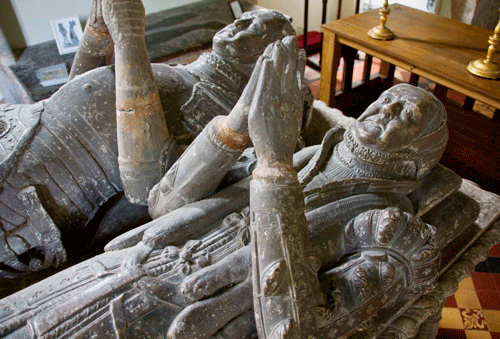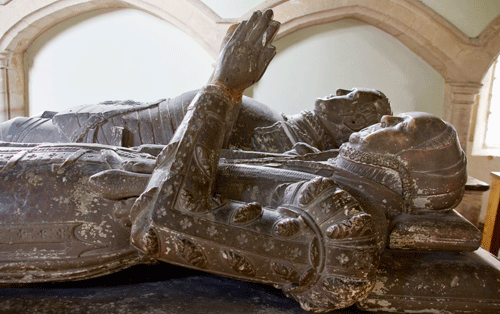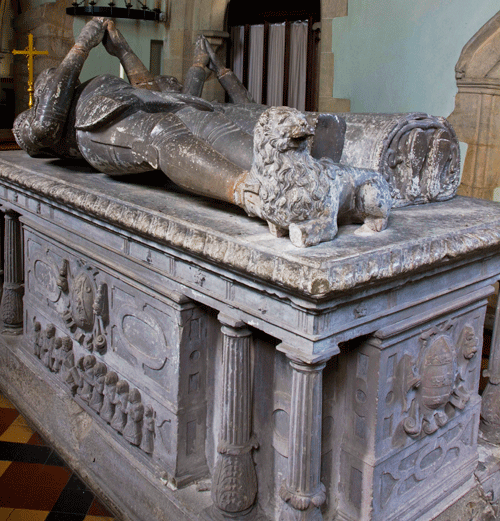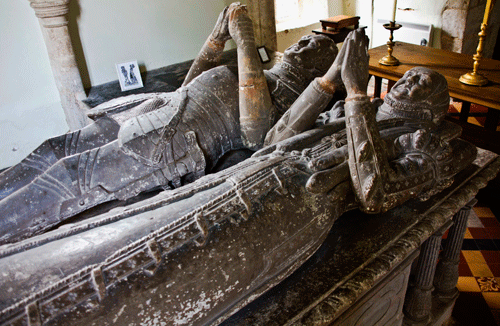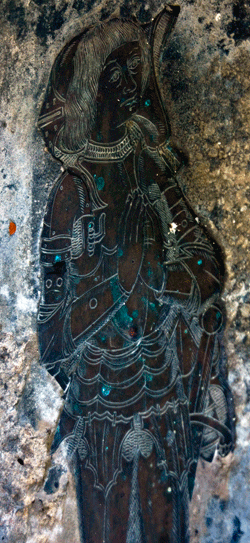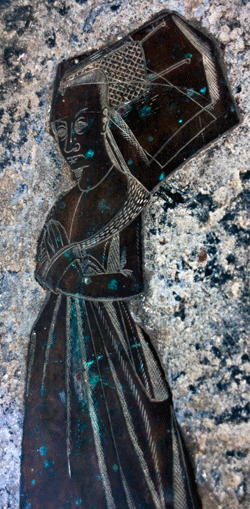 |
BUCKINGHAMSHIRE |
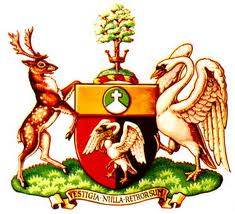 |
| Hughenden Chilton Dorney Drayton Beauchamp Haversham Hillesden Lillingstone Dayrell Middle Claydon Newport Pagnall Stoke Mandeville Stowe Whaddon Wing |
| Hughenden - St Michael & All Angels |
 |
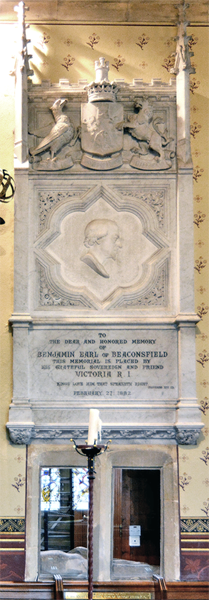 |
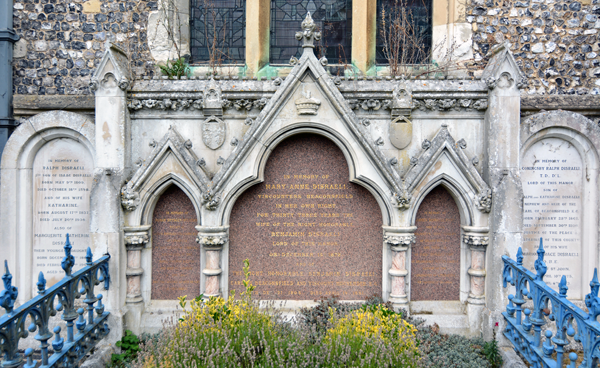 |
|
| Above top: Knight late 14th
century Above bottom: Graves of Disraeli himself, his wife (1872), nephew and others. Right: Benjamin Disraeli, Lord Beaconsfield (1881) The famous Victorian prime minister. This was erected on the order of Queen Victoria; note that the inscription, in typical aristocratic manner, refers to the Earl of Beaconfield with no mention of Disraeli, by which he is known by just about everyone else. Marble with bust by R C Belt. Below can just be see a cadaver efigy of the earl 16th C |
| There is also a knight with cross legs in 13th century style which is a fake, time Henry VIII, so that the then lords of the manor, the Wellesbourne family, could 'prove' their descent from Simon de Montford. The genuine 14th century knight also received a bogus coat of arms at this time. Three fake 15 th century knights were also made as well as fake seals and deeds. (Pevsner) |
| Chilton - St Mary the Virgin |
| Church open during daylight hours. Park in street outside O/S Ref: SP 686 116 |
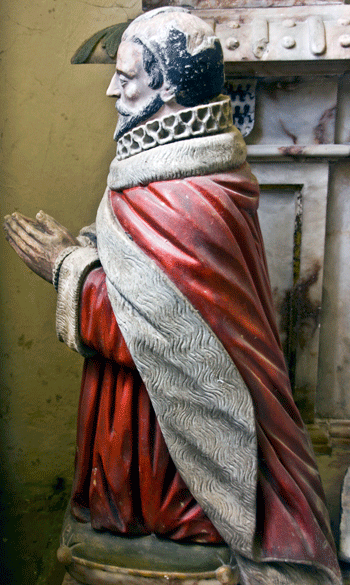 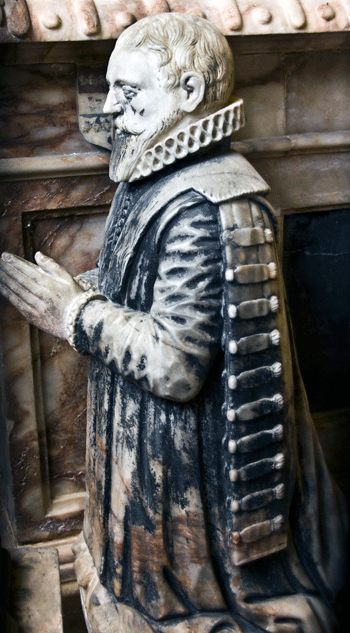 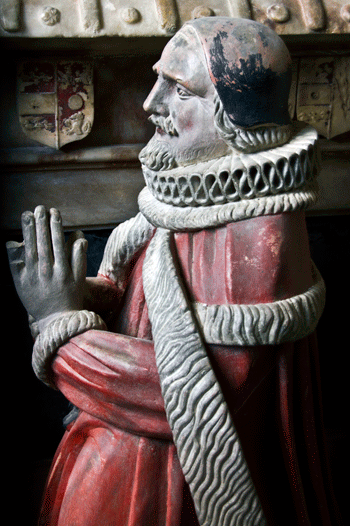 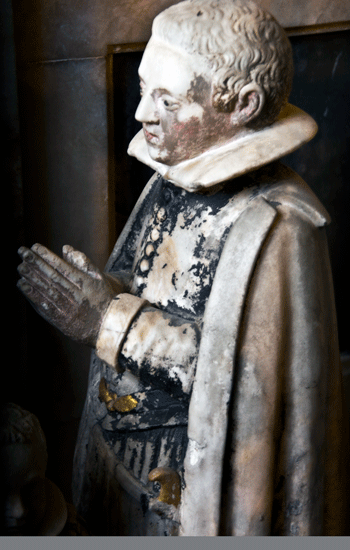 |
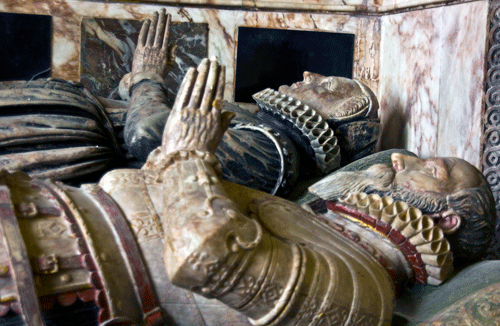 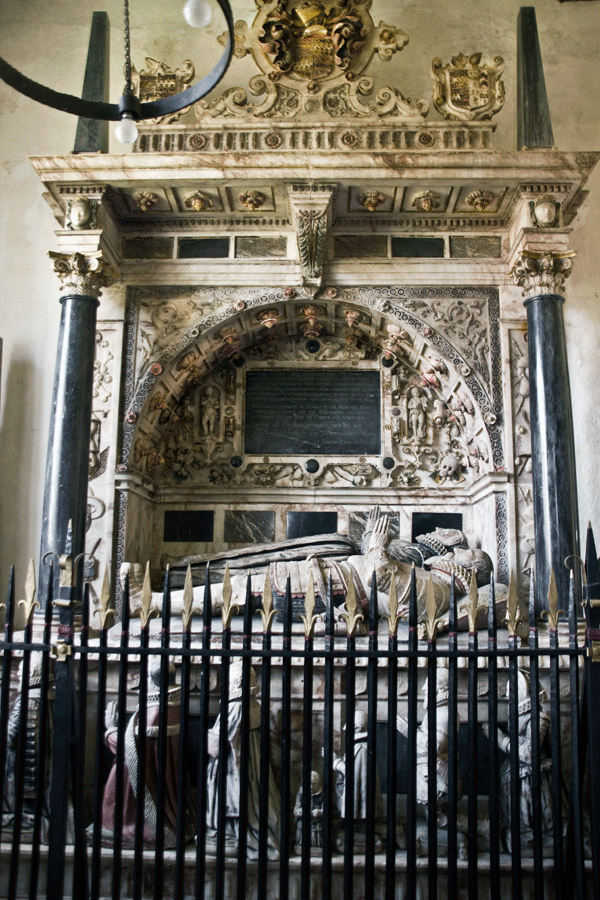 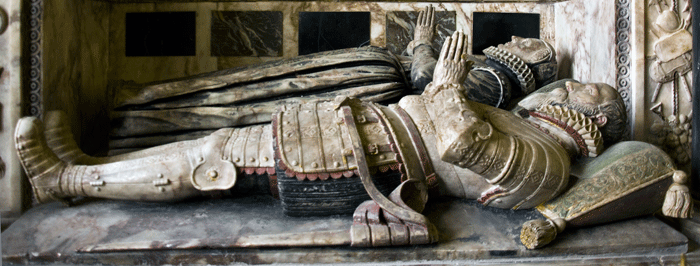 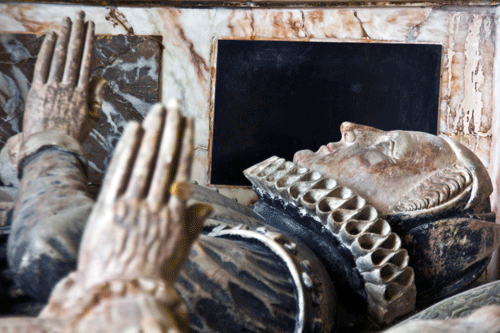 |
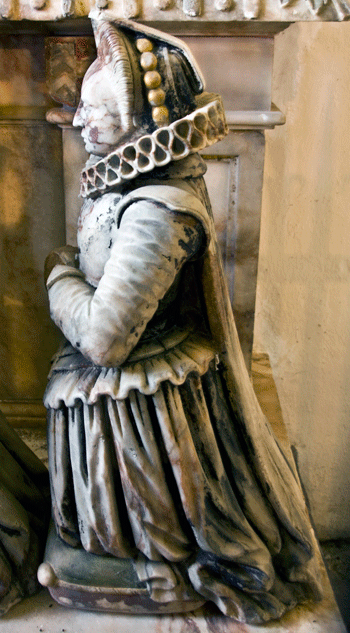 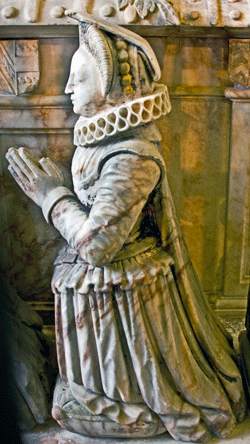 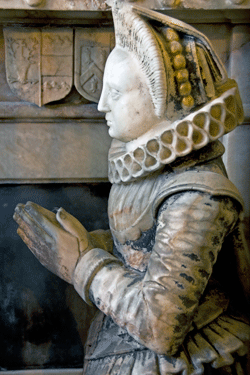  |
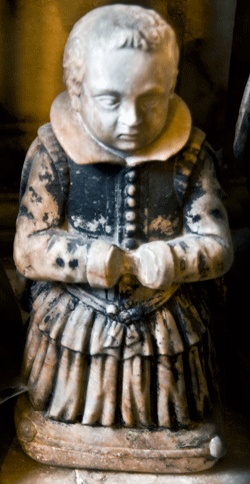
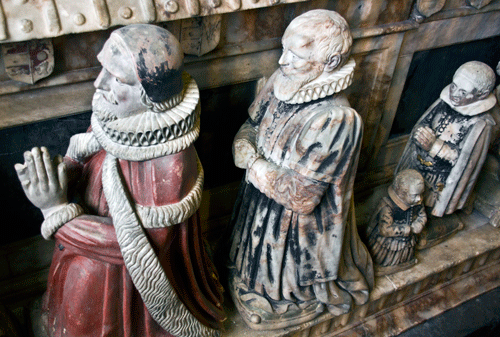
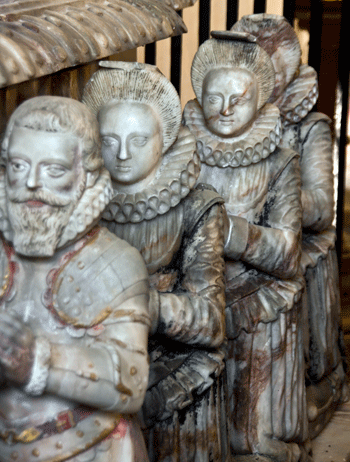
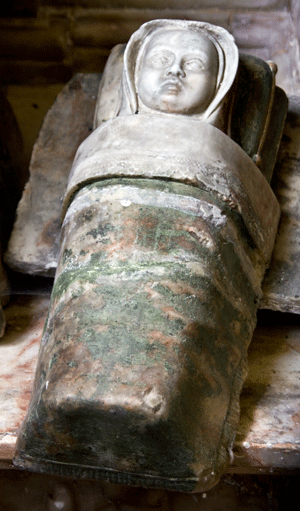 |
||
| Sir John (1608) & Elizabeth Croke (1611) Alabaster, in the Croke chapel. The two sons in scarlet robes of judges are Sir John, who was speaker of the House of Commons in the reign of Elizabeth I, and Sir George who was one of the two judges who sat in the judgment against Charles I in the Ship Money case brought by John Hampden | ||
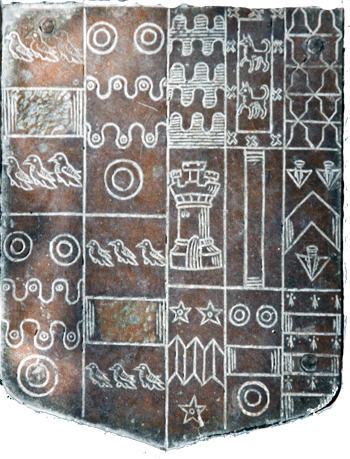 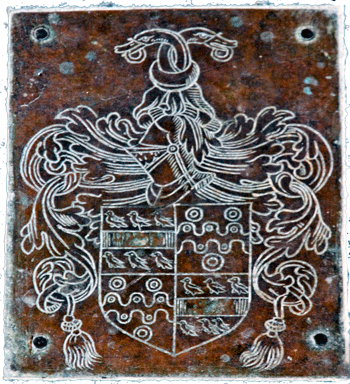 |
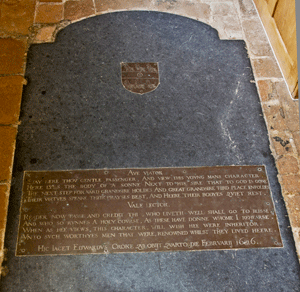 |
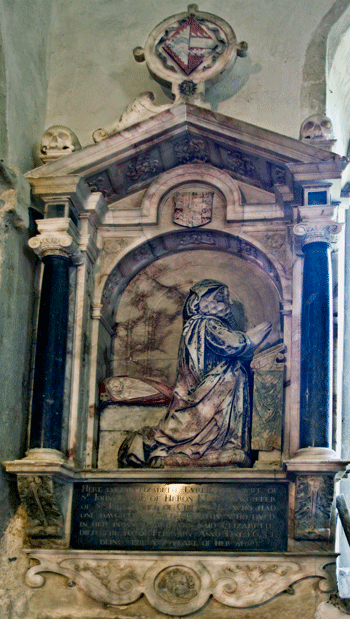 |
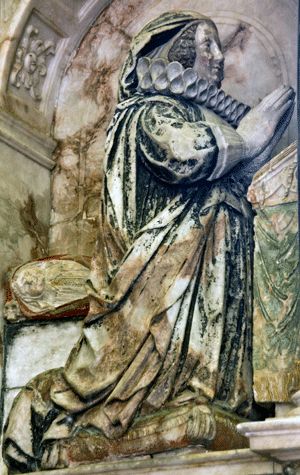 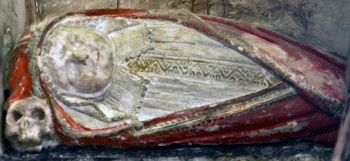 |
| Left Top: Croke Arms and
Bottom: Croke Family Brass Above: Edward Croke (1626) One the sons of the above. Floor slab with inlaid brasses. Right & Far Right: Elizabeth Tyreil (1631) & Baby Dorothy. Attributed to William Wright 'Here lyeth Elizabeth Tyreil late wife of Sir John Tyreil of Heron knight and daughter of Sir John Croke (the above) of Chilton knight who had one daughter Dorothy who dyed in her infancie and the said Elizabeth died the 16th of Frebruary Annon Domini 1631 being the 57 yeare of her age. Her parent lie in the fabulous _ on the opposite wall. |
| Edward Croke's Epitaph |
| Ave Viator Stay here thou gentle passanger and view this young mans character. Here lyes the body of a sonne next to his sire that to God is gone. the next step forward grandsire holdes and great grandsire third place enfoldes their virtues speake their prayses best, and heare their bodyes quiet rest. Vale lector reader now passes and thee who liveth well shall go to blisse and so runnes a holy course as these have done whome i rehearse. When as he views this character will wish hee were inheritor unto such worthyes men that were renowned whilst they lived heere. Hic iacet Edward Croke qui obit 4 day February 1626. |
| Dorney - St James |
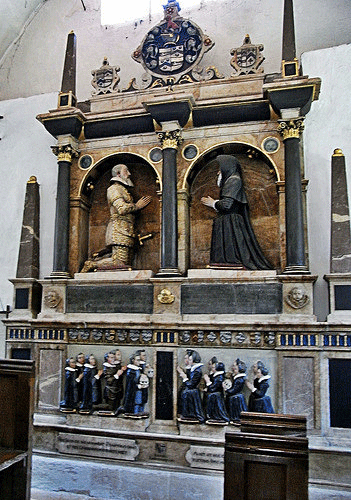 |
Sir William Gerrard (1606) & Elizabeth (Roe). Alabaster. It was erected by Sir William's widow and completed by her son-in-law, Sir John Kederminster, whose name appears at the bottom. |
| Drayton Beauchamp - St Mary the Virgin |
| Open during daylight hours. Located in the
middle of a field: to park you have to open the field gate and
drive up the church lane, where there is only spaces for two cars . O/S Ref: SP 901 118 |
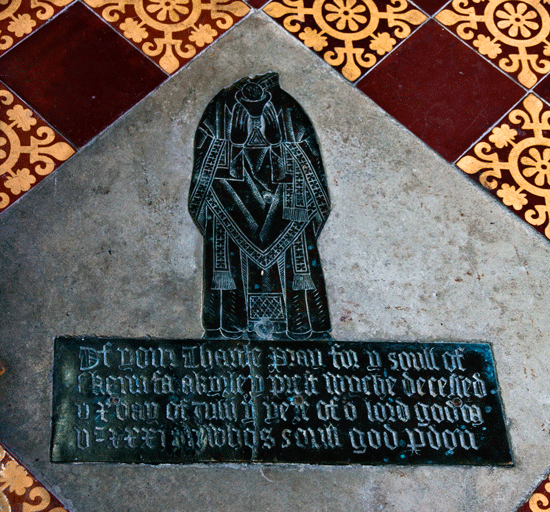 |
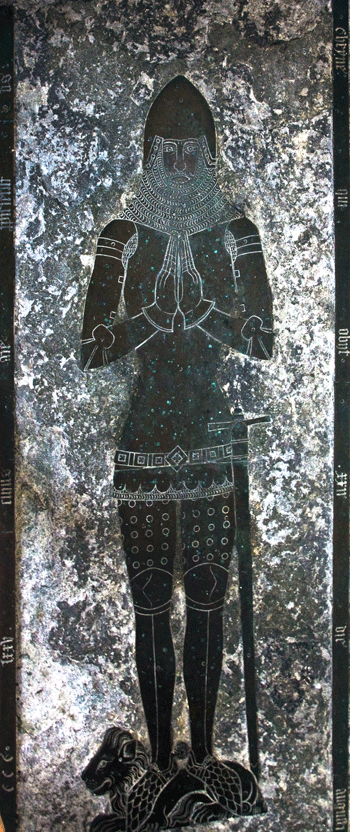 |
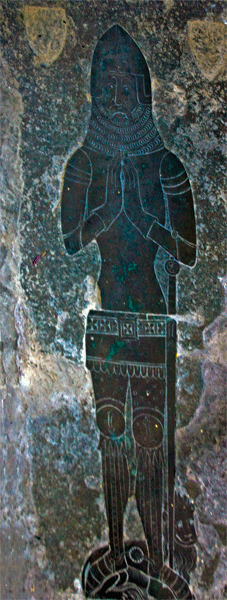 |
| Above:
Henry Fazakerley (1531)
Priest.
Now headless priest; English inscription Right: Thomas Cheyney (1368) Shieldbearer to King Edward III Far Right: William Cheyney (1374) The brother of Thomas |
 William Lord Cheyney, Viscount Newhaven (1728) By William Woodman. The seated figure of Lady Newhaven (1731) was added after her death by William Woodman the Younger |
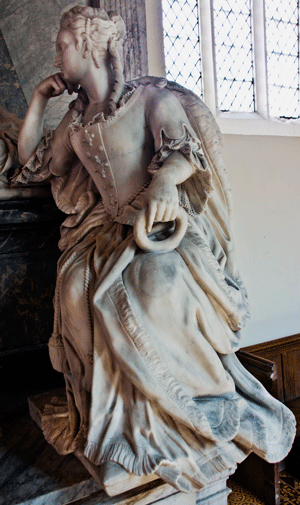 |
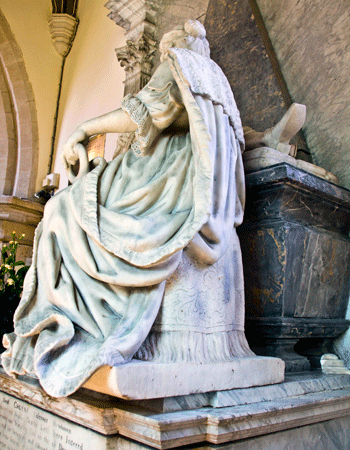 |
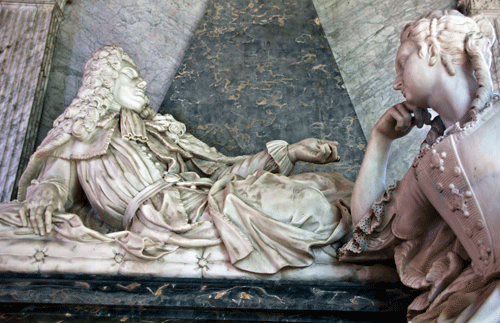 |
||
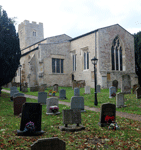 |
Haversham - St Mary |
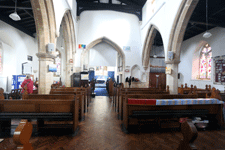 |
| The church is locked so write to or telephone the
Rector -
details on
church website - who will arrange for it to be opened. A
friendly welcome. You
may park outside the church. The nearby village pub had closed and for
sale when we visited in 2018 O/S Ref: SP 828 428 |
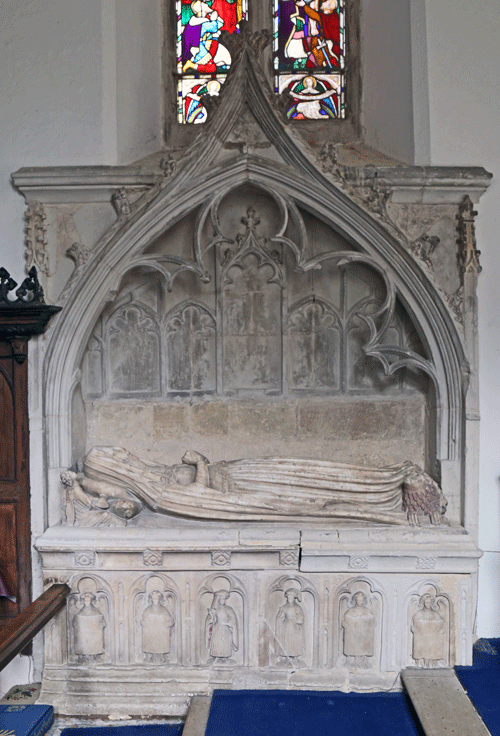 Lady (1390) Alabaster |
 |
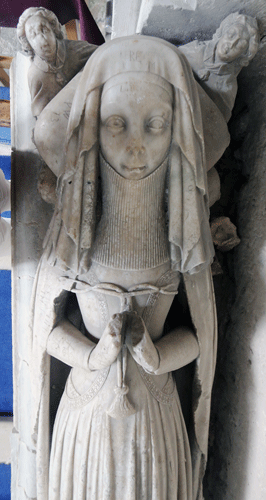 |
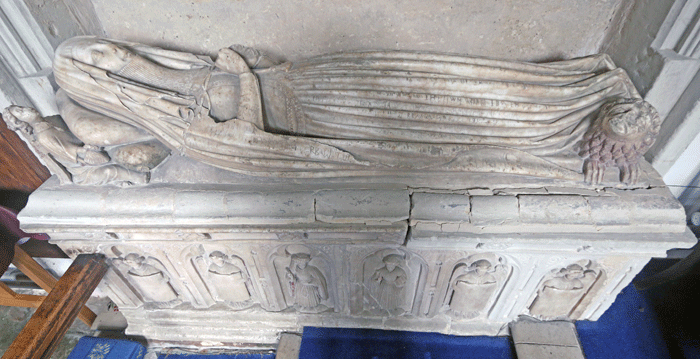 |
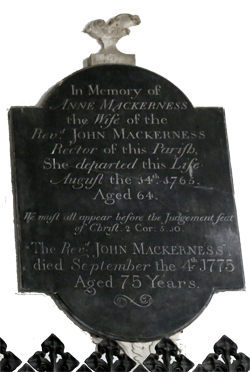 |
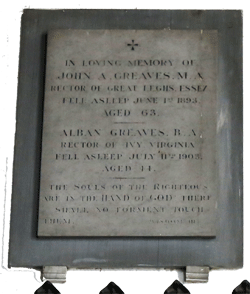 |
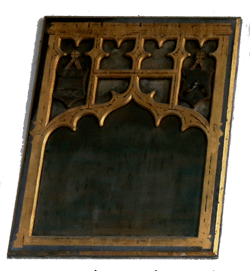  |
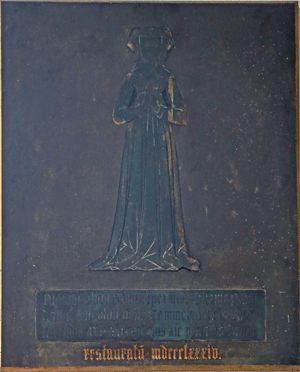 |
 |
| Above from Left to Right: 1. Anne Mackerness (1765) , the wife of John Mackerness (1775) Rector of this parish. 2. John Greaves MA (1893) Rector of Great Leghs, Essex; Alban Greaves BA (1903) Rector of Ivy Virginia. 3. Illegible. As can be seen these tablets are placed high above a wooden screen. 3. Maria Small (1829) aged 21; her husband Rev Harry Alexander Small (1876) aged 64. 4. Alicia Payn (1427) Brass restored in 1884 according to the added inscription. This brass is placed high on the south chancel wall and is very difficult to make out. 5. John Maunsell (1605) Skeleton type; chancel floor, under carpet. | ||||
| Hillesdon - All Saints |
| Open during daylight hours. Limited parking on street outside O/S: SP 685 287 |
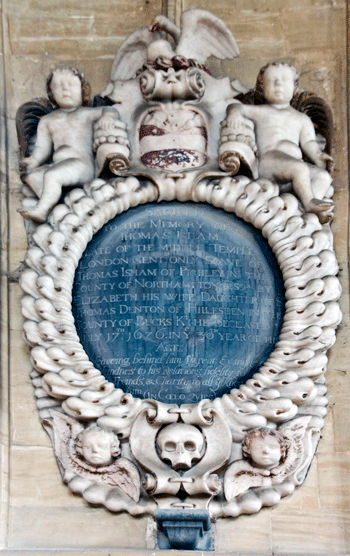 |
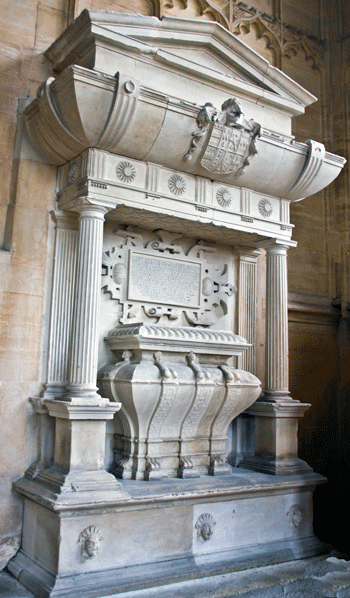 |
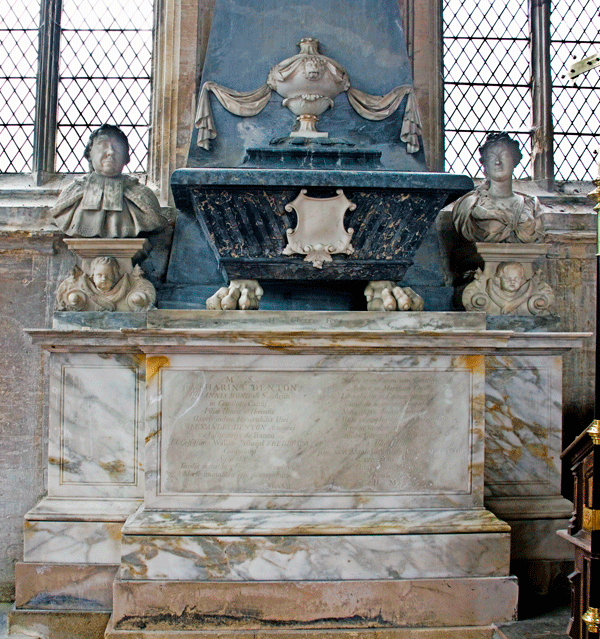 |
| Above: 'Sacred to the memory of Thomas
Isham (1676) late of Middle Temple London gent only sonne of
Thomas Isham of Pinchley in the county of Bucks knight. He
deceased July 7th in ye 30th year of his age. Leaving behind him a great example of kindness to his relations, fidelity to his friends and charity to all ye knew him. in coelo quies.' Right: Alexander Denton (1576) son of Thomas Denton (q.v.). Signed by Thomas Kirkby. His first wife was Anne Williston who died in childbirth; she has a monument in Hereford Cathedral where she lies with effigies of her baby and husband. His second wife Mary Martin is recorded on this monument; she died in 1574 Far Right: Sir Alexander (1739) and Lady Agnes Denton (1753) Originally erected for Alexander's first wife Catherine (1733), who is represented by the lion footed black marble sarcophagus in the centre of the monument, on it large obelisk. Signed by Henry Cheere. On the left is the bust of Alexander & on the right that of his second wife Agnes. |
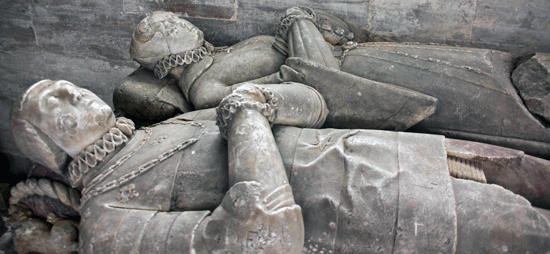 |
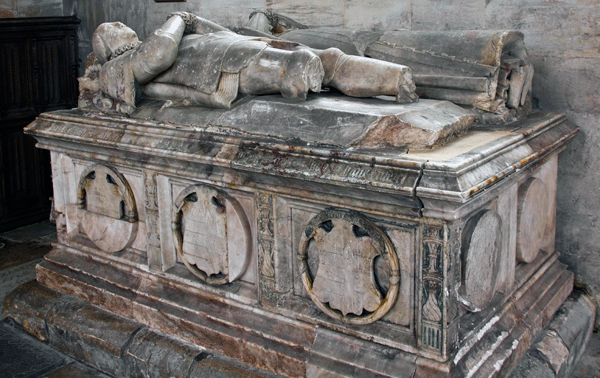 |
| Thomas Denton (1558) and Margery Mordaunt MP and lawyer in Tudor times. By Richard Parker. His wife was first married to Edmund Fettisplace of Besselsleigh, Berkshire, and she in depicted with him and their children on a brass in All Saints, Morcham |
| Lillingstone Dayrell - The Church in the Field |
| Open during daylight hours. Limited parking outside the church. O/S Ref: SP 705 398 |
|
|
|||||||||
| Middle Claydon - All Saints |
| The church is in the grounds of Claydon House; see National Trust for opening times. O/S Ref: SP 719 253 |
| Some Brasses |
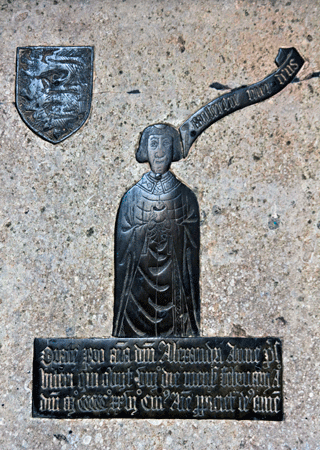 |
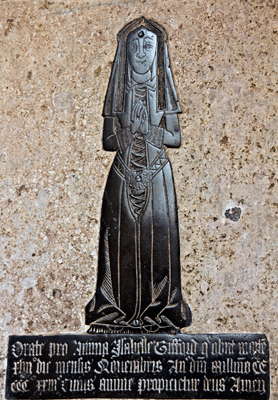 |
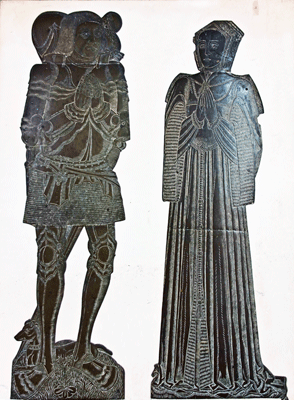 |
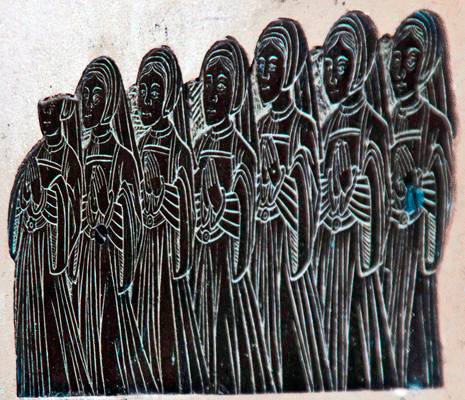 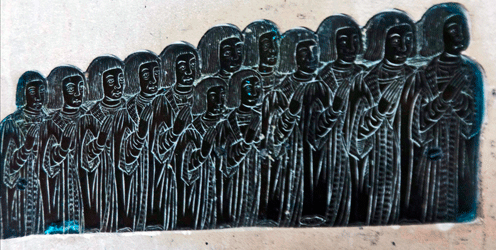 |
| Alexander Anne (1526)
priest |
Isabella Giffard (1523) | Roger (1542) & Mary Giffard The brass was created in their lifetimes but the dates of death was not added. Their 13 sons and 7 daughters are below. Right | |
| The Verney Monument 1653 'A House Divided' |
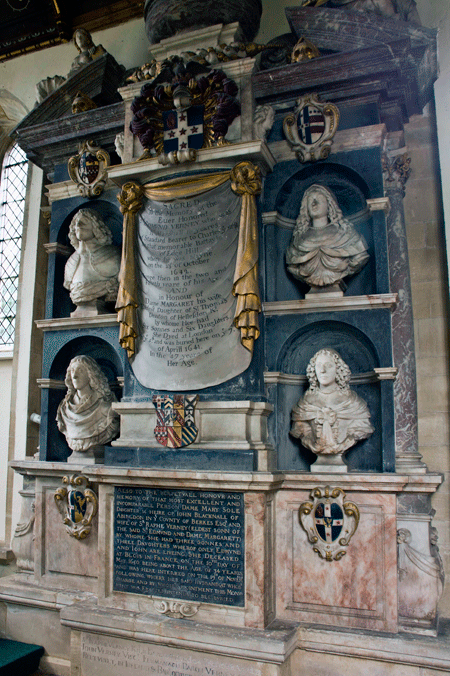 Sir Edmund (1642) & Dame Margaret (1641) Verney; their son Sir Ralph (___) and his wife Mary (1640) This monument of dark and white marbles was set up by Sir Ralph in memory of his father, mother and wife. These three busts were modeled from paintings that hung in Claydon House. When he returned to England in 1653 he signed a contract with the sculptor Edward Marshall to make the monument for £130; it took three and a half years to construct and was finished and unveiled in 1653. Edmund Verney (1590-1642) fought for the Royalists in the Civil War, becoming standard bearer, and was killed at the Battle of Edgehill. His body was never recovered, only his gauntlet covered hand, which had been hacked off, being found; this hangs with his helmet in the chancel. Ralph Verney (1613-1696) He declared for Parliament in the Civil War, but refused to sign the Solemn League and Covenant and was forced into exile. He was imprisoned on his return to England but three years later was fined and released. |
 |
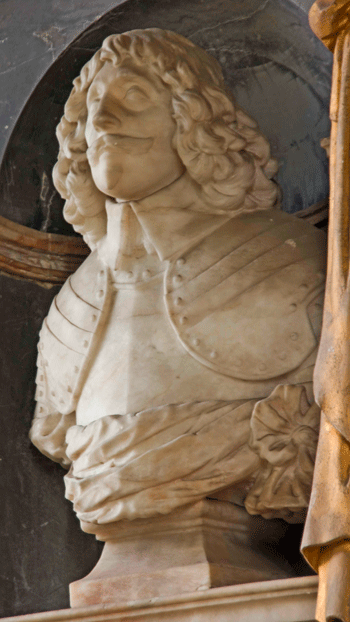 |
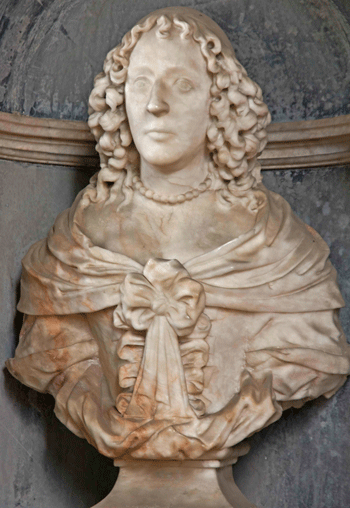 |
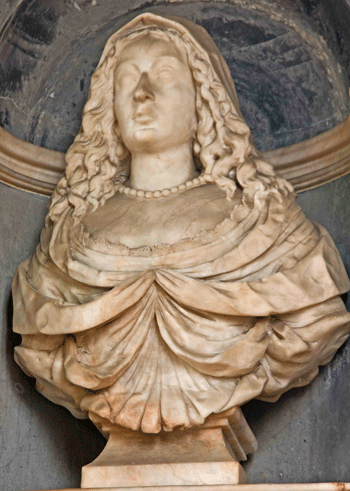 |
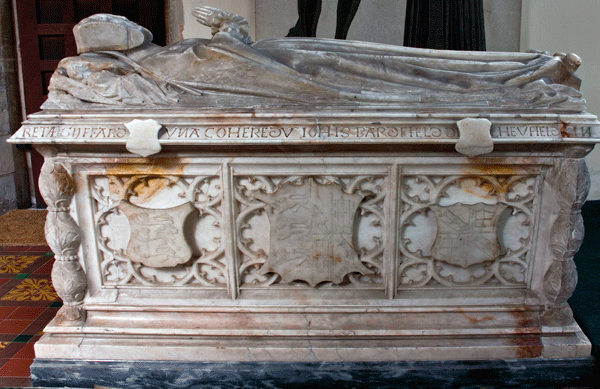 |
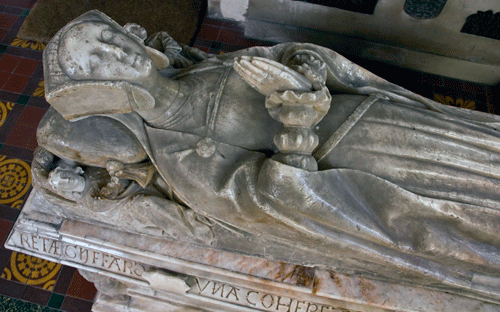 |
| Margaret Gifford
(1539) Alabaster |
 |
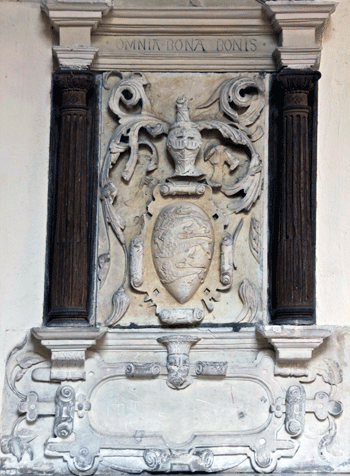 |
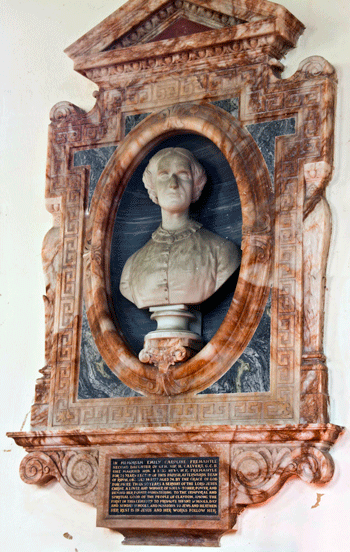 |
| Above and then from Left to Right: Catherine Verney (1827) Unnamed but shows Gifford arms. Dated by RCHM c 1540 Emily Fremantle (1877) She was the wife of Rev W R Fremantle, who was rector here and later Dean of Ripon. |
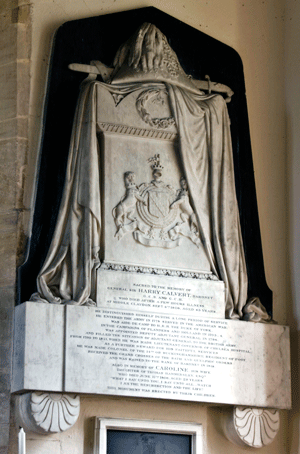 |
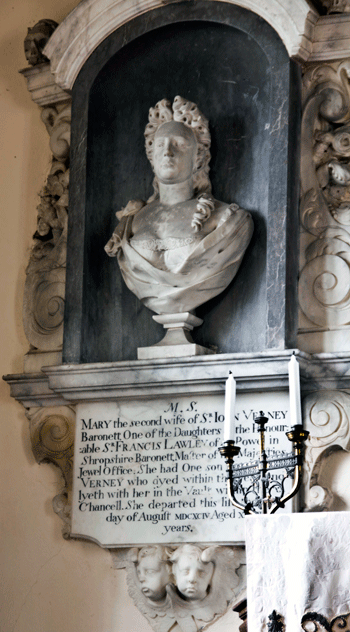 |
 |
| General Sir Harry Calvert (1826), First Baronet; Also his wife Caroline (1806) | Mary Verny (1694) | Uriah (1608) & Lettice Verney 'I...made this monument for myselfe and my wife Lettice Verney...with whom I had issue of one sonne Edmund Verney ...' |
| Newport Pagnell - St Peter and St Paul |
 |
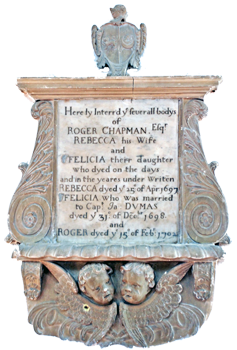 |
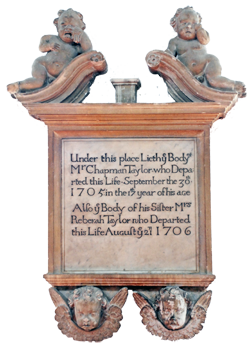 |
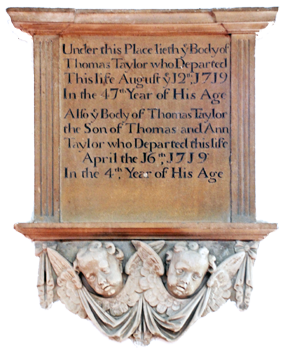 |
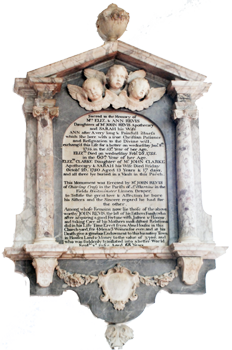 |
 Sarah Needham (1813) at 1yr 5ms; her father, Rev Charles Kipling (1841), perpetual curate of Stony Stratford and formerly vicar of this parish. Also William Kipling Cox (1834) at 4ms, infant son of William Kipling Cox and his wife, Caroline (Howe). Also Charles Hoddle Cox (1844) at 39, surgeon and eldest son of Rev Charles, above; and his wife, Mary (1846). Added below: Clarissa Anne Kipling (1855) at 30, daughter of Rev Charles; Caroline Miles Kipling (1853), wife of Rev Charles. |
| [0] Roger Chapman (1702); his wife, Rebecca (1697); and their daughter, Felicia (1698) | Chapman Taylor (1705), and his sister, Mrs Rebecca Taylor (1706) | Thomas Taylor (1719); and his son, Thomas (1719) | Sisters: Mrs Eliz (1755) 53, Ann (1755) 60 & Elizabeth (1750) 13 Revis; their father, John Revis (1765) 68. Apothecary and philanthropist |
| Note only the first of the above (labelled [0]! are before the RCHM's cut off date. | |
| Other Monumnets | |
| Brass of civilian, late 14th century. Worn and discoloured. Now on door of stair turret. | |
| Indent of male figure and small square indent, early 16th century | |
| S1 | Sir Richard Atkins (1696) Floor slab with shield of arms and Ulster badge |
| S2 | John (1701) and Mary Barton (1699) Floor slab |
| S3 | 1680 Illegible floor slab used as paving stone |
| Stoke Mandeville |
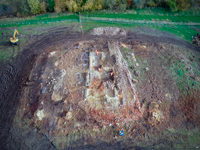 |
| When
Amanda visited Stoke Manderville she found it
locked but saw an effigy though the window which she found
attractive and interesting; she
photographed it thought the window. As
she expected the photograph was not a good one but we both
thought it worthy of publication. The church is the new church
built in the 1860's to replace the nearby Norman church that had
fallen into dereliction; it is kept locked except during
services. The monument was moved from the old
to the new in the 1880's. The old church is at the time of
writing subject to an archaeological dig as HS2 will
unfortunately (and unnecessarily) run over the remains. O/S Ref: SP 834 104 |
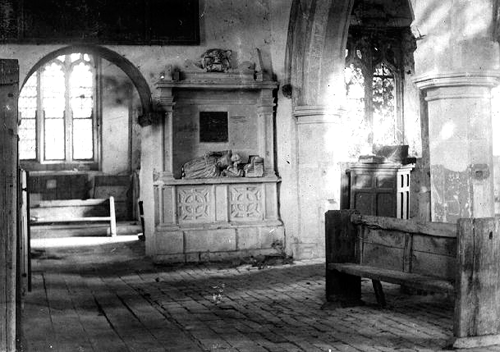 |
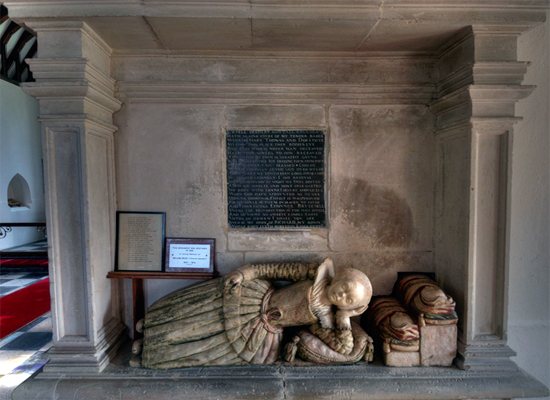 |
| The Three Children of Edmund Blundendell |
The Three Children of Edmund Blundendell |
'Crvell death by mortall blades/ Hath slain fovre of my tender babes Wherof Mary Thomas and Dorathye/ Within this place ther bodies lye. But God which never man deceaved/ Hath ther soules to Him receaved This death to them is greatest gayne/ Increasing their joy freeing them from payne O Dorathye my blessed Childe/ Which lovingly lyved and dyed myld Thou wert my tenth even God's own choys/ In thee exceedingly I did reioyse Upon Good Friday at night my doll depted/ Adew my sweet and most trvehearted My bodye with thine I desire should lye/ When God hath appointed me to dye Hoping through Christ he will provide/ For my soul with thyne in heaven to abide And I your father Edmund Brundenell/ Until the resurection with thee will dwell And so adew my sweet lambs three/ Until in heaven I shall you see Such is my hope of Richard my son/ Whose body lieth buried in Kings Sutton |
The photographs and information were kindly supplied by Ms Honor Lewington
| Stowe - Church of the Asumption |
| In the grounds Stowe Gardens; the church is the only remaining part of the medieval village. See National Trust for opening details. O/S Ref: SP 676 373 |
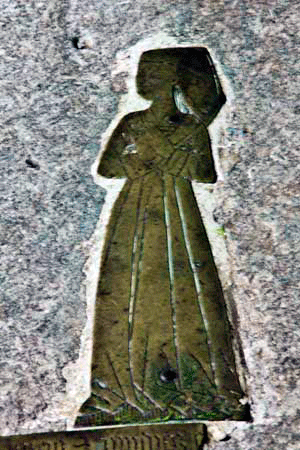 |
 |
| Above:Anna Saunders (1454)
Brass Left: 14th Century Civilian Effigy |
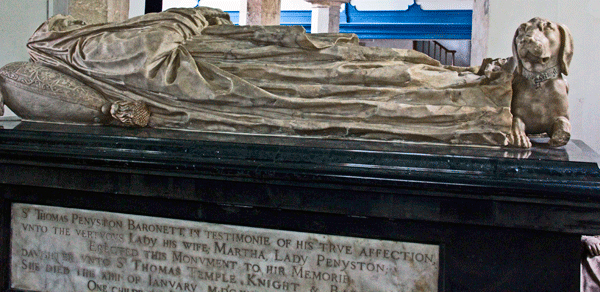 |
 |
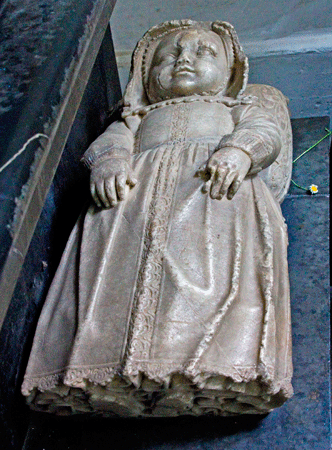 |
| Martha, Lady Prenystone (1620 age 25) & Hester (1612 <1) White marble effigy in shroud. The infant daughter is shown at her feet. She died of smallpox. She lived with her husband, Thomas, at Bruce Castle, Tottenham, which was leased from the 3rd Earl of Dorset, whose mistress she became in 1619. The monument was erected by her father. Attributed to Nicholas Stone. The baby appears to be resting on a separate (or at least lower) slab below the mother's feet; I can just see the baby's hand in the photograph above. |
| Epitaph | |
| Shut in the sepulchre lyes the ashes of faire Penyston, who lov'd by the most worthy of her time remov'd to heav'n, so to fraw up hir lovers eyes to the divine beawtie of that deitie, wherein she may love all that love hir, and not sinne. | |
| Whaddon - St Mary |
.png) |
.png) |
| Above: 'Here lyeth Thomas Pygott
in the countey of Buk late sergeant at lawe & Agnesand
Elizabeth one of the daughters & Hyeres of
John Iwardeby esquyer hys Wyffes which Thomas dyed the 24
day of February the yere of oure Lorde 1520
and the seyd Elizabeth dyed the ...day of...the yere of oure
Lord...on whose souls Jesu have mercy'. The brass is on the
back plate of the tomb structure which consists of tomb
chest and canopy, a design common in early 16th century.
Purbeck marble. Right: : Margart Myssenden (Hodges) (1612) with her son shown as a skeleton |
| Wing - All Saints |
| Open during daylight hours; refreshments served around 10 am on Saturdays. Limited parking in nearby streets. O/S Ref: SP 880 225 |
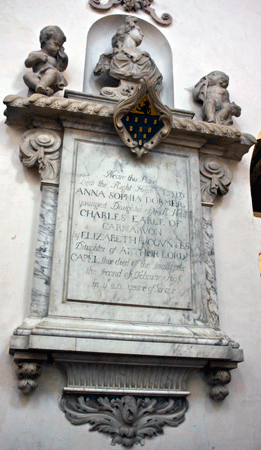 |
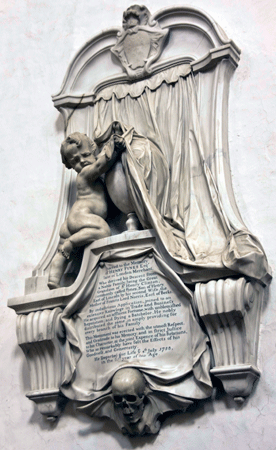 |
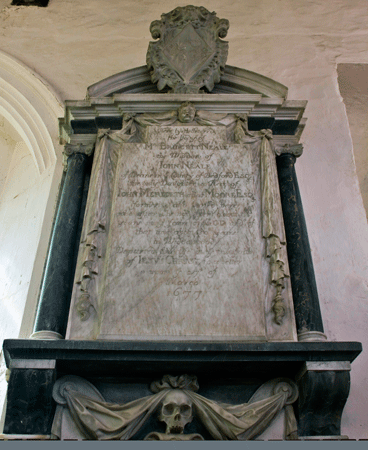 |
| Anna Sophia
Dormer (1694/5) Died of
smallpox at 22 Perhaps by James Hardy |
Henry Fynes (1758)
Merchant. By Louis François Roubiliac |
John Neale (1677) |
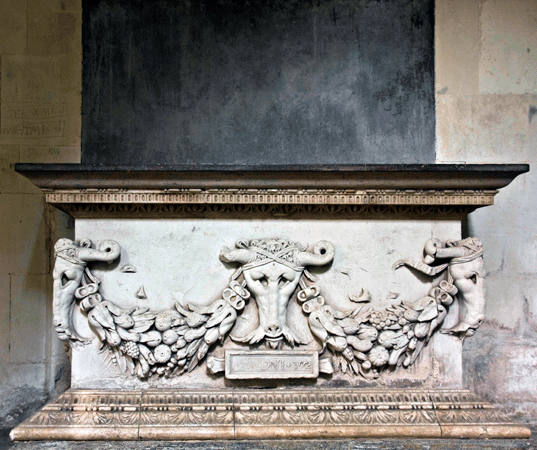 |
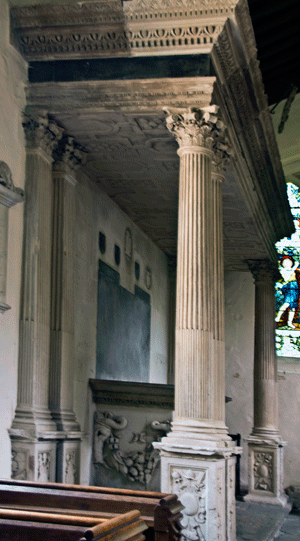 |
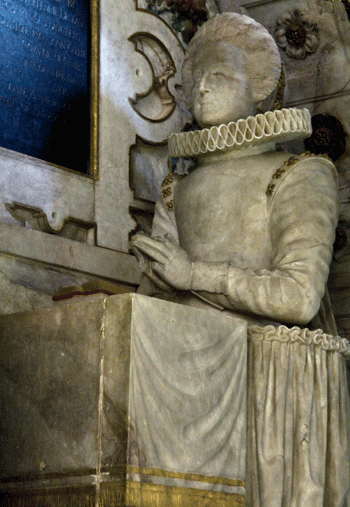 |
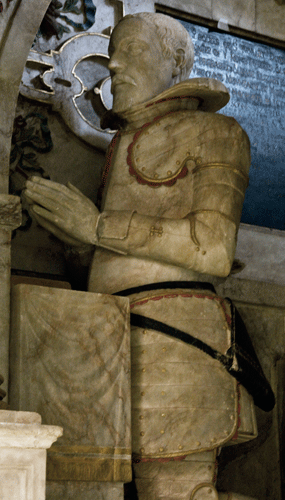 |
| Sir Robert Dormer (1552). This monument may have been made at least 15 years later for his son Sir William (1575) . The brass on the back panel refers to his granddaughter, Jane, who was the wife of the Duke of Feria, a titled not conferred on him until1567. His wife, Jane, chose to live abroad because of the Catholic intolerance during Elizabeth I's reign and is buried in the Charterhouse in Louvain. |
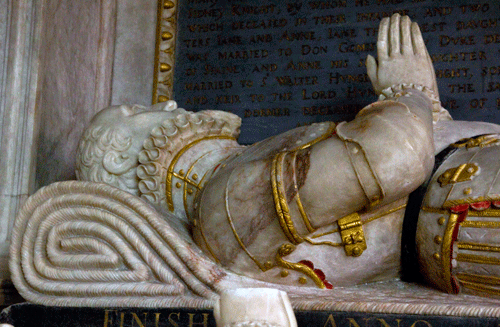 |
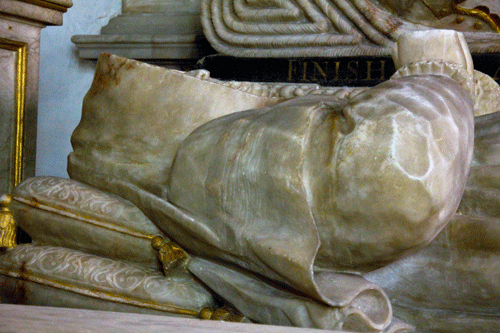 |
 |
| Sir William (1575) and Dame Dorothy (1613) Dormer.
They had several children who
are represented on the lower part of the monument. Sir
William's first wife was Mary Sidney but she is not
represented on the monument. Although a Catholic family,
they outwardly conformed but sheltered priests during the
reign of Edward VI. Dame Dorothy married Sir William Pelham.
after the death of her husband. The photographs of the Dormer monuments were taken during their restoration in 2011 |
||
